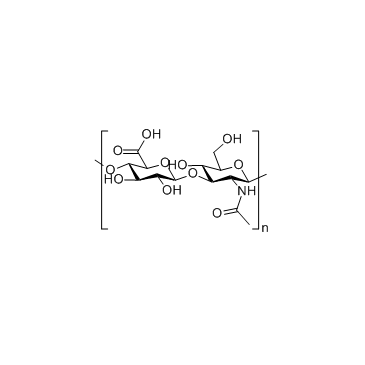Hyaluronic acid |
| Catalog No.GC32732 |
Hyaluronic acid (HA) is a biopolymer composed of repeating units of disaccharides, which include molecules of D-glucuronic acid and N-acetylglucosamine molecules linked by β- (1 4) and β- (1 3)glycosides.
Products are for research use only. Not for human use. We do not sell to patients.

Cas No.: 9004-61-9
Sample solution is provided at 25 µL, 10mM.
Hyaluronic acid (HA) is a biopolymer composed of repeating units of disaccharides, which include molecules of D-glucuronic acid and N-acetylglucosamine molecules linked by β- (1 4) and β- (1 3)glycosides. It belongs to a group of substances called mucopolysaccharides belonging to the glycosaminoglycans (GAGs) family[1]. Hyaluronic acid also plays an important role in wound healing, ovulation, fertilization, signal transduction, and tumor physiology[2,3].
Hyaluronic acid oligosaccharides of a specific size range induce CD44 cleavage from tumor cells. It raise the possibility that small Hyaluronic acid oligosaccharides, which are known to occur in various tumor tissues, promote tumor invasion by enhancing the tumor cell motility that may be driven by CD44 cleavage[4]. Hyaluronic acid enhances tumor cell adhesion and migration and activates the Ras-mitogen-activated protein kinase pathway as well as the phosphoinositide 3-kinase pathway[5]. Purified autologous adipose-derived stem cells (ADSCs) combined with Hyaluronic acid facilitated adipose tissue regeneration in a rabbit subcutaneous model[7].
In mice, Cross-linked Hyaluronic acid had minimal effect on the early retention rate of surrounding fat grafts, but enhanced their vascularization. Fat grafts should be not injected into lumps of cross-linked HA. Therefore, agglomerated cross-linked Hyaluronic acid should be dissolved before fat transplantation[6]. Hyaluronic acid-NP treatment of diet-induced obese (DIO) mice reduced the epididymal fat mass and suppressed the induction of adipogenic and lipogenic regulators, while these effects were attenuated in the CD44-null mice[8]. In the animal study, the mice were fed a high-fat diet and treated with Clenbuterol by oral administration, or injected with Clenbuterol-modified Hyaluronic acid hydrogel (HAC) regularly. Both groups showed reduction in whole-body, visceral, and gonadal fat contents and body weight. The abdominal fat was analyzed using MRI imaging in adipose mode and water mode. The abdominal fat ratio in the mice treated with normal diet and those given intra-adipose injections with HAC had the lowest value among the test groups[9].
References:
[1]. Salwowska NM, Bebenek KA, et,al.Physiochemical properties and application of hyaluronic acid: a systematic review. J Cosmet Dermatol. 2016 Dec;15(4):520-526. doi: 10.1111/jocd.12237. Epub 2016 Jun 21. PMID: 27324942.
[2]. HAMERMAN D, SCHUSTER H. Hyaluronate in normal human synovial fluid. J Clin Invest. 1958 Jan;37(1):57-64. doi: 10.1172/JCI103585. PMID: 13491713; PMCID: PMC293057.
[3]. Toole BP. Hyaluronan: from extracellular glue to pericellular cue. Nat Rev Cancer. 2004 Jul;4(7):528-39. doi: 10.1038/nrc1391. PMID: 15229478.
[4]. Sugahara KN, Murai T, et,al. Hyaluronan oligosaccharides induce CD44 cleavage and promote cell migration in CD44-expressing tumor cells. J Biol Chem. 2003 Aug 22;278(34):32259-65. doi: 10.1074/jbc.M300347200. Epub 2003 Jun 11. PMID: 12801931.
[5]. Sohara Y, Ishiguro N, et,al. Hyaluronan activates cell motility of v-Src-transformed cells via Ras-mitogen-activated protein kinase and phosphoinositide 3-kinase-Akt in a tumor-specific manner. Mol Biol Cell. 2001 Jun;12(6):1859-68. doi: 10.1091/mbc.12.6.1859. PMID: 11408591; PMCID: PMC37347.
[6]. Zheng Z, Lei X, et,al.Changes in Human Fat Injected Alongside Hyaluronic Acid in the Backs of Nude Mice. Aesthet Surg J. 2021 May 18;41(6):NP631-NP642. doi: 10.1093/asj/sjaa351. PMID: 33326559.
[7]. Piccinno MS, Veronesi E, et,al. Adipose stromal/stem cells assist fat transplantation reducing necrosis and increasing graft performance. Apoptosis. 2013 Oct;18(10):1274-89. doi: 10.1007/s10495-013-0878-7. PMID: 23828239; PMCID: PMC3775159.
[8]. Lee WH, Rho JG, et,al.Self-assembled hyaluronic acid nanoparticle suppresses fat accumulation via CD44 in diet-induced obese mice. Carbohydr Polym. 2020 Jun 1;237:116161. doi: 10.1016/j.carbpol.2020.116161. Epub 2020 Mar 18. PMID: 32241446.
[9]. Chen WY, Lin FH. Oxidized Hyaluronic Acid Hydrogels as a Carrier for Constant-Release Clenbuterol Against High-Fat Diet-Induced Obesity in Mice. Front Endocrinol (Lausanne). 2021 Mar 12;12:572690. doi: 10.3389/fendo.2021.572690. PMID: 33776904; PMCID: PMC7996091.
Average Rating: 5 (Based on Reviews and 20 reference(s) in Google Scholar.)
GLPBIO products are for RESEARCH USE ONLY. Please make sure your review or question is research based.
Required fields are marked with *



















